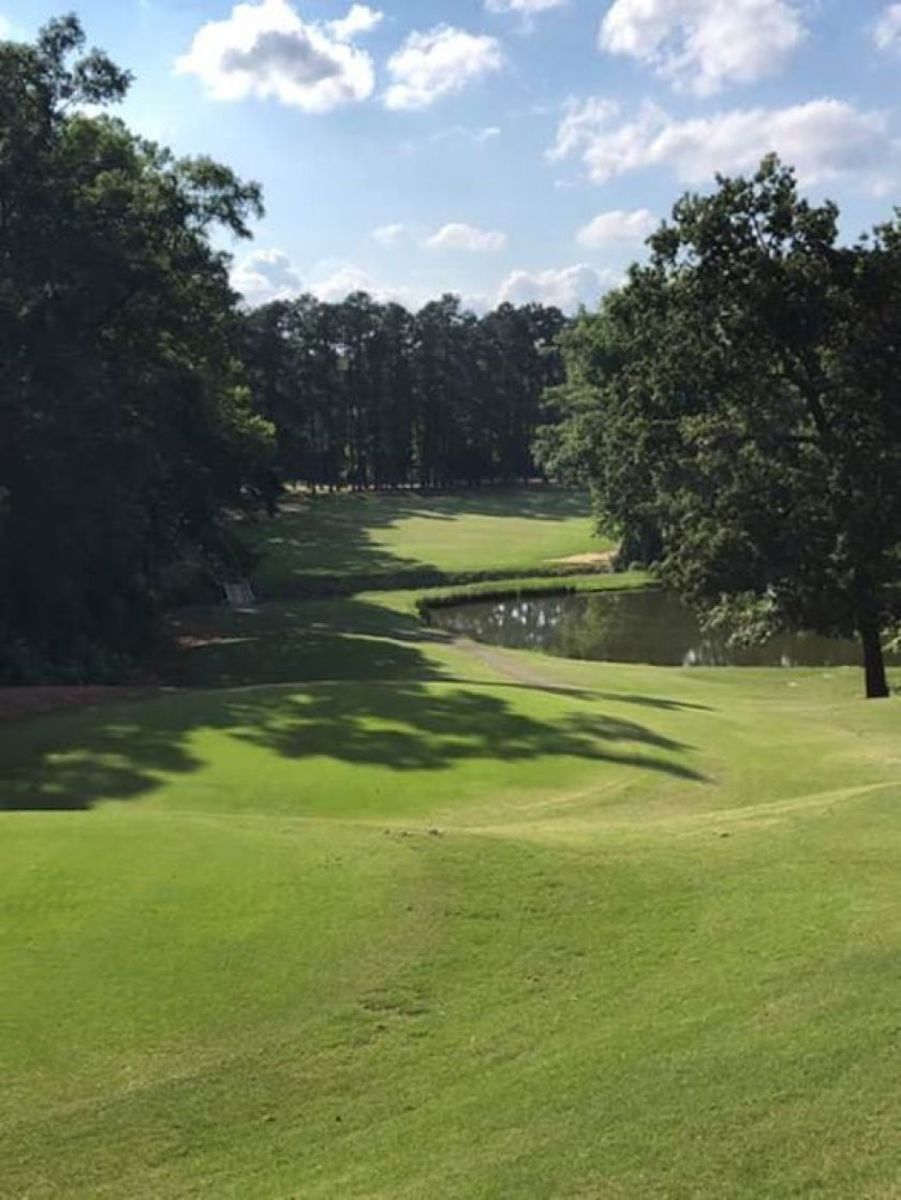College sports' greatest rivalries also have some great golf courses nearby

Rivalries are the lifeblood of college athletics. If you’re a casual fan, a game between two bitter rivals is appointment TV. If you’re a stakeholder in the contest — student, alumnus, community booster — the outcome can change lives. Family feuds, smashed televisions and untold humiliations that follow a lost wager are only parts of the fun.
But where would life be without our special rivalries?
So much emotion rides on these games that it’s often impossible to predict who will triumph during rivalry week. Therefore, let’s tip the scales by examining three supreme college rivalries and forecasting a winner in each, based on one factor — whose golf course is better.
OHIO STATE VS. MICHIGAN
The Rivalry: Arguably the fiercest college football rivalry of all, Ohio State and Michigan have met every year since 1900, except for a stretch between 1913 and 1917 — and it appears in 2020. A Big Ten Championship and a top-tier bowl bid are usually on the line when these two play. Ohio State holds the recent edge, winning 16 of the past 17 contests, but Michigan continues to lead overall, 58-51-6. An anecdote involving former Buckeyes coach Woody Hayes illustrates the wrath felt from one program to the other. In the 1968 game in Columbus, Hayes’ team scored a late touchdown to pad its lead to 50-14. Rather than tack on an extra point, Hayes chose to go for two points. When asked why he went for two, Hayes reportedly responded, “Because they wouldn’t let me go for three.”
The Courses: Ohio State and Michigan are rarities in that each has a championship-caliber golf course designed by Alister MacKenzie, considered one of history’s greatest course architects. They were the only two college campus courses MacKenzie ever did. In each instance he was assisted by Perry Maxwell, an all-time great in his own right.
Ohio State’s Scarlet is the Buckeyes' championship course and former OSU star Tom Weiskopf lauded its “unbelievable change of direction” and MacKenzie’s bunker work. Though MacKenzie designed the course in 1931, it wasn’t built until 1938, well after MacKenzie died in 1934. Maxwell completed MacKenzie’s plans, but the greens were finished by John S. McCoy and lack the flair for which MacKenzie — and Maxwell — were renowned.
Former Ohio St. All-American Jack Nicklaus redesigned the bunkers in 2006, making them bigger, deeper and bolder in contour, controversially so, as they’re now much more demanding for the average golfer. He also moved two holes and resurfaced the greens, but did not rebuild them.

By contrast, MacKenzie’s genius for green design is on full display at Michigan. Built to his specifications by Maxwell in 1931, Michigan’s compact layout boasts wonderful elevation changes and a heart-of-the-campus location — in full view of “The Big House,” America’s largest football stadium with a capacity of more than 107,000. Short by today’s standards and hemmed in by many parallel fairways, the Blue nonetheless delights with some holes framed by mature trees and others by tall native fescue grasses. Nevertheless, it’s the putting surfaces that distinguish the course.
Most memorable is the topsy-turvy green at the 537-yard, par-5 third hole, which has ripples like ocean swells. The horseshoe-shaped green at the 308-yard, par-4 sixth is another standout. Many of the greens are elevated, making the course play longer than listed. In each case, once aboard, it’s a vexing experience trying to gauge the read and pace.
Michigan graduate Arthur Hills restored many of the bunkers in 1994, among other tweaks. Not everything he did was pure MacKenzie, but he certainly kept intact the Golden Age essence. In a comment that could cost him his Buckeye helmet sticker, Weiskopf stated, “Alister MacKenzie’s University of Michigan course is just as good as Ohio State’s, if not better.”
The Verdict: Ohio State's Scarlet came in as a five-point favorite. It ranked No. 6 among Golfweek’s best college courses for 2019, whereas Michigan ranked 11th. The Scarlet Course has hosted 10 NCAA Division 1 Men’s Championships and four Women’s Championships. Michigan played host to just one NCAA final, in 1947.
Playing 7,455 yards, the par-71 Scarlet Course has a rating of 76.2 from the tips and a slope of 138, and offers the superior modern test compared to Michigan’s Wolverine tees at 6,730 yards, 72.8 rating and 135 slope. Michigan benefits from its character-filled routing, superb campus location and an outstanding set of Alister MacKenzie/Perry Maxwell greens. But for Michigan football games, cars are parked on the grass of the championship course.
Winner: Ohio State wins by a narrow margin, 34-31.

NORTH CAROLINA VS. DUKE
The Rivalry: When these two schools meet in football, the rest of America stifles a yawn. When NCAA hoops season rolls around, it’s a vastly different story. College basketball’s greatest rivalry for quality, competitiveness and drama is right here — the Tar Heels against the Blue Devils. The distance between schools is less than 10 miles, but the world tunes in at least twice year to watch two basketball bluebloods battle for Atlantic Coast Conference regular season and tournament glory. Usually at stake is a No. 1 NCAA tournament seed. And while there are NBA No. 1 draft picks and future Hall of Famers in every game, there’s just as much intensity off the court as the disdain between the Cameron Crazies and the Carolina Blue faithful in the Dean Dome is real.
The series began in 1920 and North Carolina leads all-time, 139-114. Duke coach Mike Krzyzewski put the rivalry in perspective a few years back. “It (the Duke-UNC rivalry) will always be great. It transcends players and coaches.” More spirited was this tweet from former Tar Heel star and NBA player Kendall Marshall, who posted in 2013: “#dookfans are them kids growin up that reminded the teacher she didn’t collect homework.” Ouch.

The Courses: Proximity isn’t the only thing that the courses at Duke and North Carolina share. Both layouts were originally crafted in the 1950s — Duke’s in 1957 by Robert Trent Jones Sr. and Carolina’s in 1951 by George Cobb. Jones’ design always garnered more admiration for its challenge. Carolina’s course, known as UNC Finley, perhaps was best known as the venue where All-American Tar Heel Davis Love III showed classmate Michael Jordan how to grip a golf club.
Both courses experienced 1990s makeovers. Carolina’s course underwent a radical transformation, with Tom Fazio essentially crafting a new course on the old site. In typical Fazio fashion, it’s very playable, amid a profusion of attractive water hazards and artfully sculpted bunkers, though it’s a load from the tips. Back-to-back card-wreckers arrive at the 490-yard, par-4 15th and the 445-yard, par-4 16th. The former features an elevated tee, a right-to-left-sloping fairway and water along the entire left side of the hole. The latter demands a long carry over an environmentally sensitive area, followed by a rugged approach that plays 30 feet uphill to the green. Both are beautiful brutes.
Duke’s transformation in 1993-94 by Rees Jones wasn’t as jarring. He added length and bunkers where needed to keep up with the current collegiate crop. In 2013, Jones returned, and expanded putting surfaces back to their original 1957 dimensions. Streams, hardwoods, tall pines, deep greenside bunkers and elevated, Champion Bermuda greens add aesthetic appeal and challenge, while the compact, if hilly routing makes for a wonderful walking workout. Duke answers with its own two stern, scenic consecutive uphill par-4s, the 439-yard 17th and the 455-yard 18th.
The Verdict: Duke was a half-point favorite by virtue of its ranking as Golfweek’s 17th best college course in the country in 2019. North Carolina was right behind, at No. 18 — but up six spots from the year before. Duke stretches 7,154 yards, with a rating from the Championship tees of 73.9 and a slope of 141. UNC-Finley runs 7,223 yards, with a 74.9 rating and a 138 slope. Duke’s terrain is superior, yet Finley wins for variety. After regulation, the score is tied. However, Duke twice hosted the NCAA Championships in 1962, when Rees Jones competed there for Yale and again in 2001. UNC Finley has never had the honor.
Winner: Duke in overtime, 86-84.

OKLAHOMA VS. TEXAS
The Rivalry: The annual Oklahoma-Texas football contest takes place every October at the Cotton Bowl in Dallas, a neutral site, in conjunction with the Texas State Fair. The game goes by a variety of names: The Red River Rivalry, the Red River Showdown, the Red River Shootout or the Red River Classic. Regardless of which version of this Red River fight strikes your fancy, it is a monumental, mayhem-filled match-up year after year.
Texas leads all-time 62-48-5. Invariably, both teams come into the game nationally ranked, with Big 12 title and National Championship aspirations on the line. Nine Heisman Trophy winners have played in the Red River game. As for drama, the past six games have been decided by a touchdown or less.
In the ultimate putdown, following Oklahoma’s 63-14 thrashing of Texas in 2000, OU’s president, David Boren cancelled his school’s classes on the following Monday, citing a weather issue: “It was snowing touchdowns in Dallas.”
The Courses: The Jimmie Austin Golf Club at the University of Oklahoma emerged in the early 1950s when native Oklahoman Perry Maxwell and his son Press crafted a championship layout on the campus in Norman. Except for the renumbering of holes when a new clubhouse came on board, the course remained unchanged until the mid-1990s, when architect Bob Cupp provided a facelift.
From 2015-2017, architect Tripp Davis, an All-American member of OU’s 1989 NCAA Championship-winning team restored some of Perry Maxwell’s work and tweaked the course further, not only to accommodate today’s big bashers, but also to take full advantage of the property’s natural attributes.
“You can’t bomb and gouge it here,” said Davis. “You have to position your ball properly — play the angles — to have any chance at getting close to the hole.”
Davis installed native grass fringes to restore the prairie feel, and put back the movement in six of the greens that had become too flat. He also featured Bishop’s Creek more meaningfully.

“The 600-yard, par-5 eighth hole used to be a dogleg left, with the creek 300 feet to the right of the green,” said Davis. “We moved the green to the creek and made it a double dogleg. Now it’s the most interesting hole on the course.”
Davis observed that it’s pretty great to have such a pocket of nature so close to campus in an urban area. One highlight to being so close to the stadium, he said, is that if you play in the fall, you can hear the band practicing for their Saturday performance. “When you hear ‘Boomer Sooner,’ it’s pretty inspiring.”
The University of Texas Golf Club is a private membership club that is part of a gated housing community in the Hill Country, about 18 miles (a 30-minute drive) west of the campus. Designed by Roy Bechtol and Randy Russell in 2003, it is undeniably dramatic, with soaring elevations and stirring views of Lake Austin in a setting next to the Balcones Natural Wildlife Preserve.
An outstanding collection of par-3s will linger long in memory, but golf fans will also warm to the Walk of Fame memorabilia on each tee box and in the clubhouse. Ben Crenshaw, Tom Kite and Harvey Penick are prominently featured, as is Jordan Spieth, a member of the 2012 NCAA National Championship team who also designed the six-hole short-game course at the facility.
The Verdict: We pit one demanding, beautiful course against another. Oklahoma was the clear favorite coming in, as Golfweek bumped it up 14 spots in its 2019 ranking of college courses, to No. 5 in the U.S. Jimmie Austin at OU tips out at 7,452 yards, par 72, with a rating of 77.9 and a slope of 142. Texas answers with a 7,412-yard layout, with a 76.7 rating and a 144 slope. Texas soars with visual drama, flawless conditioning and more pulse-racing shots; Oklahoma benefits from an on-campus location, superior strategic options and more sophisticated contouring within the greens.
Winner: Oklahoma, 38-31.
Sign up to receive the Morning Read newsletter, along with Where To Golf Next and The Equipment Insider.
